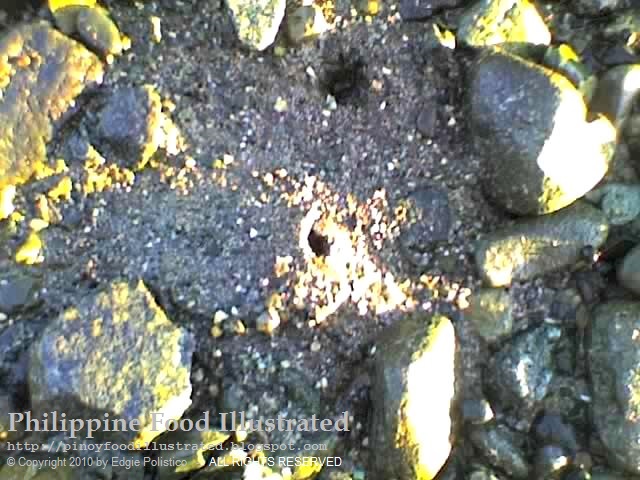sasing – /sa-sing/ Cebuano, Boholano, Davaoeño [southeastern Mindanao] and Misamis occidental [northern Mindanao], Waray, and Romblomanon worm/seafood) [n.] peanut worm (sc.name: Sipunculus nudus).
a.k.a. saypo in Boholano & Cebuano
saypo in Surigaonon
tasing in Cantilangnon (Cantilan, Surigao del sur)
A kind of sand worm or sand burrower of the family Echiurus that burrows under sandy clayish soil of the sea shore.

Sasing burrows in moist sandy-muddy ground along the shore and river deltas. A hole like this is a sign that peanut worm is just around under the sand.
It is an exotic delicacy to some Pinoys. Often eaten as kinilaw nga sasing where the cylindrical body of the worm is inverted inside out and washed thoroughly. The cleaned inverted peanut worm is then dipped in spiced vinegar and munched.
Sasing has a crunchy leathery texture and has to be chewed thoroughly to savor its flavor.
It is considered an exotic delicacy and as an aphrodisiac to some Pinoys when they visit places where sasing are found.
The worms are washed clean then inverted inside out by pushing a bamboo stick from one end and through inside the body so as to clean its muddy contents. The inverted worms are washed again thoroughly, drained and then seasoned with spiced up vinegar to become a kinilaw nga sasing.
So called peanut worm in English because when it is inverted, the inner side of the worm would look like an emptied peanut shell.
Although sasing worms live and feed in the sandy mud shores, some Filipino Muslim (followers of Islam faith) do not consider peanut worm as unclean or filth to be among those forbidden (Haram) in Islamic laws. Nevertheless, this exotic worm should be served with caution to Muslim or any followers of Islamic faith, so as not to offend or insult them
I read an old news feature of GMA Network news that some folks of Inopacan, Leyte believed sasing has curative powers against tuberculosis and anemia. Inopacnons are fond of it and would love to take kinilaw nga sasing as their pulutan with their tuba (coconut wine).
Related posts:
All photos by Edgie Polistico in this blog are copyrighted. ALL RIGHTS RESERVED.
Encouragement and enthusiasm is not enough. I also need moral support, prayers, and what else that can uplift my spirit and keep my good reasons. Keep them coming. Sharing and giving away is happiness to me. If you are pleased and happy of what I am doing, just smile and share the happiness we have in the PHILIPPINE FOOD ILLUSTRATED. I feel energized every time my blog becomes one of the reasons why you are happy and smiling.
For more about Filipino food, see this Philippine Food, Cooking, and Dining Dictionary. It is OPEN and FREE.










+watermarked.jpg)
watermarked.jpg)
watermarked.jpg)
+watermarked.jpg)
watermarked.jpg)




